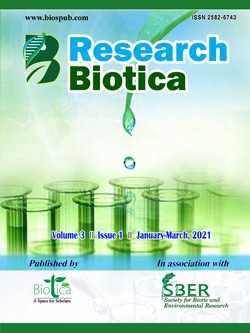
Bio-Energetics in Selected Eco-Races of Eri Silkworm
Pallavi*
College of Sericulture, Chintamani, University of Agricultural Sciences (UAS), Bangalore, Karnataka (560 065), India
Sannappa B.
DOS in Sericulture Sciences, University of Mysore, Mysuru, Karnataka (570 005), India
Ramakrishna Naika
College of Sericulture, Chintamani, University of Agricultural Sciences (UAS), Bangalore, Karnataka (560 065), India
Bharathi V.P.
College of Sericulture, Chintamani, University of Agricultural Sciences (UAS), Bangalore, Karnataka (560 065), India
DOI: https://doi.org/10.54083/ResBio/3.1.2021.13-18
Keywords: Bio-energetics, Consumption, Digestibility, Eco-races, Growth rate
Abstract
Ericulture is mainly confined to North-Eastern region of India accounting nearly 98% of eri silk produced in the country. Eri silkworm is polyphagous in habit and acclimatized to hardy climatic zones of dry lands. The availability of food plants in various states of the country has opened new vistas for the development of ericulture. An attempt has been made to work out the bio-energetics of selected eco-races of eri silkworm in relation to castor varieties. Total food consumption and digestion differed significantly among the castor hybrid/ variety and eco-races of eri silkworm. Highest total food consumption was registered when Borduar eco-race of eri silkworm was reared on the leaf of DCH-177 hybrid both on fresh and dry weight basis. Further, significantly higher mean consumption index and approximate digestibility were observed when Borduar eco-race of eri silkworm was reared on the leaves of DCH-177 castor hybrid on fresh weight basis, while it was significantly more in DCH-177 × Khanapara on dry weight basis. Mean growth rate was differed statistically between the castor hybrid/ variety and eco-races of eri silkworm and significantly more growth with DCH-177 × Borduar on fresh weight basis and DCH-177 × Mendipathar on dry weight basis.
Downloads
not found
Reference
Anonymous, 2000. Castor - Package of Practices for Increasing Production. (Eds.) Hegde, D.M. and Patil, D. Directorate of Oilseeds Research, Hyderabad. p. 20.
Basaiah, J.M.M., 1988. Consumption and utilization of castor and tapioca by the eri silkworm. M.Sc. (Seri.) Thesis, University of Agricultural Sciences, Bangalore. p. 119.
Chandrashekhar, S., 2007. Identification of suitable castor genotypes for dual purpose of ericulture and seed production. Ph.D. Thesis, University of Agricultural Sciences, Bangalore. p. 122.
Chumkijini Chhatria, Sunanda Sahoo, Rao, T.V., 2017. Feeding efficiency of eri silkworm, Philosamia ricini (H.) reared on different castor genotypes. Global Journal of Bio-Science and Biotechnology 6(1), 103-107.
Dayashankar, K.N., 1982. Performance of eri silkworm, Samia cynthia ricini Boisduval on different host plants and economics of rearing on castor under Dharwad conditions. M.Sc. (Agri.) Thesis, University of Agricultural Sciences, Bangalore. p. 86.
Devaiah, M.C., Rajashekhargouda, R., Yelshetty, S., Govindan, R., 1985. Growth and silk production in Samia cynthia ricini Boisduval fed on four different host plants. Indian Journal Sericulture 24(1), 33-35.
Dookia, B.R., 1980. Varied silk ratio in cocoons of eri silkworm (Philosamia ricini Hutt.) reared on different castor varieties in Rajasthan. Indian Journal of Sericulture 19, 38-40.
Gururaj., Kumar, K.P., Naika, R., 2017. Rearing performance of eri silkworm, Samia cynthia ricini (Boisduval) (Lepidoptera: Saturniidae) on cultivars of castor. Journal of Entomology and Zoology Studies 5(5), 816-821.
Jolly, M.S., Sen, S.K., Sonwalkar, T.N., Prasad, G.K., 1979. Non-Mulberry Silks. In: Manuals on Sericulture. Volume 4, FAO, Rome. p. 178.
Kaleemurrahaman, M., Gowri, C., 1982. Foliar constituents of the food plants of eri silkworm (Philosamia cynthia ricini). Proceedings of National Science Academy B-Biological Sciences 48, 349-353.
Kedir Shifa, 2011. Studies on the performance of eri silkworm (Samia cynthia ricini Boisduval) (Lepidoptera: Saturniidae) fed on different genotypes of castor (Ricinus communis L.). M.Sc. Thesis, Addis Ababa University, Adama, Ethiopia. p. 78.
Lakshmi Narayanamma, V., Dharma Reddy, K., Vishnuvardhan Reddy, A., 2014. Identification of promising castor genotypes for rearing eri silkworm, Samia cynthia ricini. Indian Journal of Plant Protection 42(2), 135-140.
Misra, S.D., Srivastava, A.D., 1984. Two hypotheses for the prediction of pupal date from the adjustment of consumption rates after reaching the maxima in the final instar of eri silkworm. Sericologia 24, 549-557.
Reddy, D.N.R., Baruah, A.M., Reddy, R.N., 1999. Ericulture - An overview. Bulletin of Indian Academy of Sericulture 3, 91-95.
Reddy, D.N.R., Kotikal, Y.K., Vijayendra, M., 1989. Development and silk yield of eri silkworm, Samia cynthia ricini (Lepidoptera: Saturniidae) as influenced by the food plants. Mysore Journal of Agricultural Sciences 23, 506-508.
Sannappa, B., Jayaramaiah, M., Chandrappa, D., 2002. Influence of castor genotypes on consumption indices of eri silkworm, Samia cynthia ricini Boisduval (Lepidoptera: Saturniidae). Environment and Ecology 20, 960-964.
Sannappa, B., Manjunath, D., Prakash, B.K., 2013. Efficacy of castor hybrids and varieties on nutritional efficiency in eri silkworm (Samia cynthia ricini Boisduval). Journal of Sericulture & Technology 4(1&2), 27-34.
Scriber, J.M., Feeny, P., 1979. The growth of herbivorous caterpillars in relation to degree of specialization and to growth form of food plants. Ecology 60, 829-859.
Slansky, F., Scriber, J.M., 1985. Food Consumption and Utilization. In: Comprehensive Insect Physiology, Biochemistry and Pharmacology, Volume 4. (Eds.) Kerkut, G.A. and Gilbert, L.I. Pergamon Press, Oxford. pp. 88-151.
Thangavelu, K., Boraiah, G., 1986. Ericulture. In: Lectures in Sericulture. (Ed.) Boraiah, G. Suramya Publishers, Bangalore. pp. 135-137.
Waldbauer, G.P., 1968. The consumption and utilization of food by insects. Recent Advances in Insect Physiology 5, 229-288.
